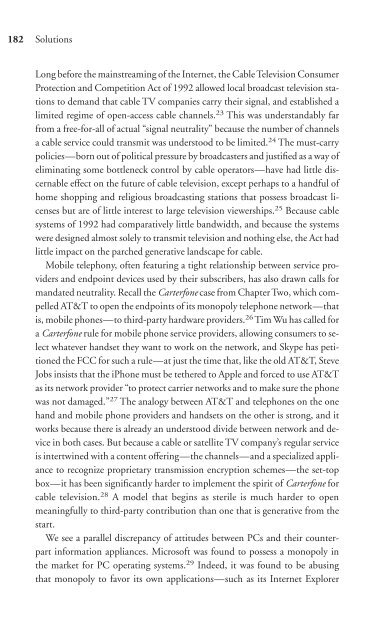Download - Future of the Internet â And how to stop it.
Download - Future of the Internet â And how to stop it.
Download - Future of the Internet â And how to stop it.
You also want an ePaper? Increase the reach of your titles
YUMPU automatically turns print PDFs into web optimized ePapers that Google loves.
182<br />
Solutions<br />
Long before <strong>the</strong> mainstreaming <strong>of</strong> <strong>the</strong> <strong>Internet</strong>, <strong>the</strong> Cable Television Consumer<br />
Protection and Compet<strong>it</strong>ion Act <strong>of</strong> 1992 allowed local broadcast television stations<br />
<strong>to</strong> demand that cable TV companies carry <strong>the</strong>ir signal, and established a<br />
lim<strong>it</strong>ed regime <strong>of</strong> open-access cable channels. 23 This was understandably far<br />
from a free-for-all <strong>of</strong> actual “signal neutral<strong>it</strong>y” because <strong>the</strong> number <strong>of</strong> channels<br />
a cable service could transm<strong>it</strong> was unders<strong>to</strong>od <strong>to</strong> be lim<strong>it</strong>ed. 24 The must-carry<br />
policies—born out <strong>of</strong> pol<strong>it</strong>ical pressure by broadcasters and justified as a way <strong>of</strong><br />
eliminating some bottleneck control by cable opera<strong>to</strong>rs—have had l<strong>it</strong>tle discernable<br />
effect on <strong>the</strong> future <strong>of</strong> cable television, except perhaps <strong>to</strong> a handful <strong>of</strong><br />
home shopping and religious broadcasting stations that possess broadcast licenses<br />
but are <strong>of</strong> l<strong>it</strong>tle interest <strong>to</strong> large television viewerships. 25 Because cable<br />
systems <strong>of</strong> 1992 had comparatively l<strong>it</strong>tle bandwidth, and because <strong>the</strong> systems<br />
were designed almost solely <strong>to</strong> transm<strong>it</strong> television and nothing else, <strong>the</strong> Act had<br />
l<strong>it</strong>tle impact on <strong>the</strong> parched generative landscape for cable.<br />
Mobile telephony, <strong>of</strong>ten featuring a tight relationship between service providers<br />
and endpoint devices used by <strong>the</strong>ir subscribers, has also drawn calls for<br />
mandated neutral<strong>it</strong>y. Recall <strong>the</strong> Carterfone case from Chapter Two, which compelled<br />
AT&T <strong>to</strong> open <strong>the</strong> endpoints <strong>of</strong> <strong>it</strong>s monopoly telephone network—that<br />
is, mobile phones—<strong>to</strong> third-party hardware providers. 26 Tim Wu has called for<br />
a Carterfone rule for mobile phone service providers, allowing consumers <strong>to</strong> select<br />
whatever handset <strong>the</strong>y want <strong>to</strong> work on <strong>the</strong> network, and Skype has pet<strong>it</strong>ioned<br />
<strong>the</strong> FCC for such a rule—at just <strong>the</strong> time that, like <strong>the</strong> old AT&T, Steve<br />
Jobs insists that <strong>the</strong> iPhone must be te<strong>the</strong>red <strong>to</strong> Apple and forced <strong>to</strong> use AT&T<br />
as <strong>it</strong>s network provider “<strong>to</strong> protect carrier networks and <strong>to</strong> make sure <strong>the</strong> phone<br />
was not damaged.” 27 The analogy between AT&T and telephones on <strong>the</strong> one<br />
hand and mobile phone providers and handsets on <strong>the</strong> o<strong>the</strong>r is strong, and <strong>it</strong><br />
works because <strong>the</strong>re is already an unders<strong>to</strong>od divide between network and device<br />
in both cases. But because a cable or satell<strong>it</strong>e TV company’s regular service<br />
is intertwined w<strong>it</strong>h a content <strong>of</strong>fering—<strong>the</strong> channels—and a specialized appliance<br />
<strong>to</strong> recognize proprietary transmission encryption schemes—<strong>the</strong> set-<strong>to</strong>p<br />
box—<strong>it</strong> has been significantly harder <strong>to</strong> implement <strong>the</strong> spir<strong>it</strong> <strong>of</strong> Carterfone for<br />
cable television. 28 A model that begins as sterile is much harder <strong>to</strong> open<br />
meaningfully <strong>to</strong> third-party contribution than one that is generative from <strong>the</strong><br />
start.<br />
We see a parallel discrepancy <strong>of</strong> att<strong>it</strong>udes between PCs and <strong>the</strong>ir counterpart<br />
information appliances. Micros<strong>of</strong>t was found <strong>to</strong> possess a monopoly in<br />
<strong>the</strong> market for PC operating systems. 29 Indeed, <strong>it</strong> was found <strong>to</strong> be abusing<br />
that monopoly <strong>to</strong> favor <strong>it</strong>s own applications—such as <strong>it</strong>s <strong>Internet</strong> Explorer


